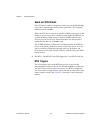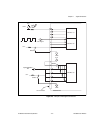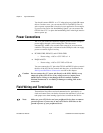
Chapter 4 Signal Connections
DIO 6533 User Manual 4-12 © National Instruments Corporation
For unstrobed operations, you have a choice of two types of output
drivers: standard and wired-OR. A standard driver drives its output pin
to approximately 0 V for logic low, or +5 V for logic high. A standard
driver has several advantages:
• It does not rely on pull-up resistors.
• It is independent of the state of the DPULL line.
• It has high current drive for both its logic high and logic low states.
• It can drive high-speed transitions in both the high-to-low and
low-to-high directions.
A wired-OR output driver drives its output pin to 0 V for logic low, but
floats (tri-states) the pin for logic high. Therefore, a wired-OR output
driver requires a pull-up resistor to pull the pin to +5 V for logic high.
To provide a pull-up resistor, you can connect the DPULL pin on the
I/O connector to the +5 V pin, making the 6533 device 100 kΩ
pull-down resistors into 100 kΩ pull-up resistors. A wired-OR driver
has the following advantages over a standard driver:
• You can connect two or more wired-OR outputs together without
damaging the drivers.
• You can connect wired-OR outputs to open-collector drivers, to
GND signals, or to switches connecting to GND signals, without
damaging the drivers.
• You can use wired-OR outputs bidirectionally. For example, after
connecting wired-OR outputs together, you can read back the value
of one of the pins to determine whether any of the connected
outputs is logic low.
Note: As of NI-DAQ 5.1, LabVIEW does not support wired-OR outputs.
Strobed I/O
Strobed operations, such as pattern generation and handshaking, use the
same data signal connections as unstrobed operations, with the
following exceptions:
• You can configure data signals only on a port-by-port basis, rather
than on a pin-by-pin basis. To configure data ports, you must assign
them to handshaking groups.
• Strobed output operations use only standard, rather than wired-OR,
output drivers.


















